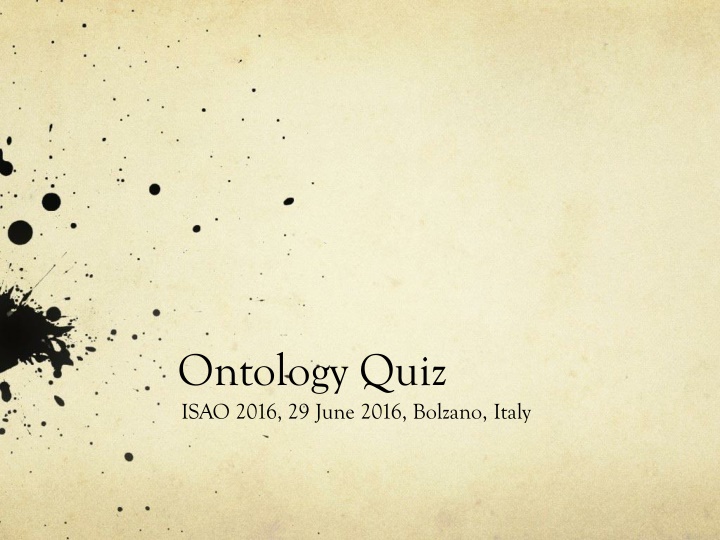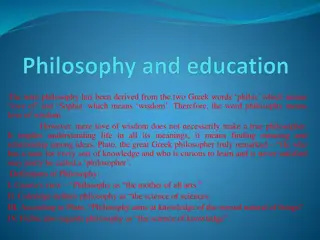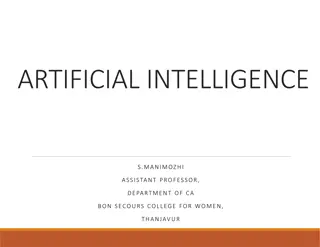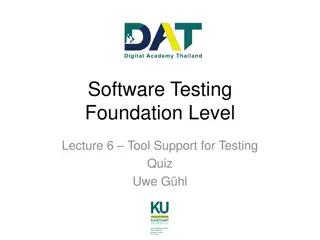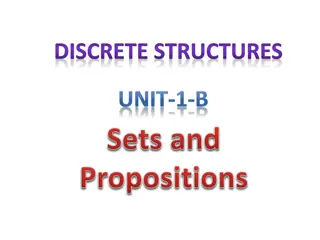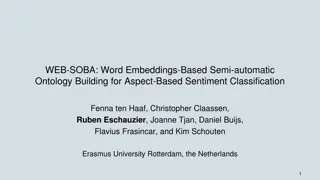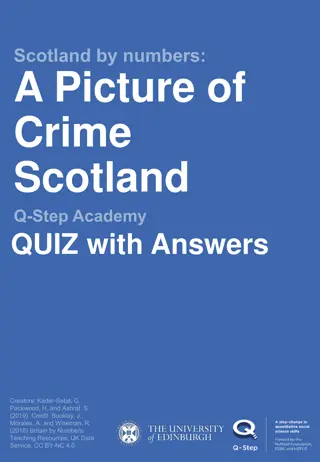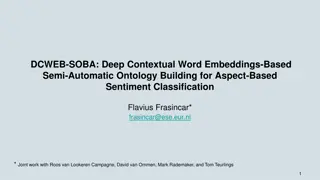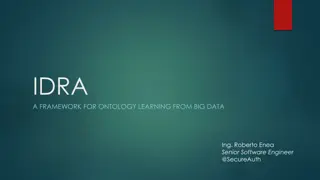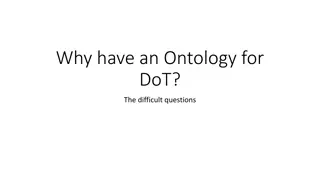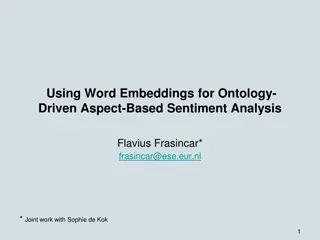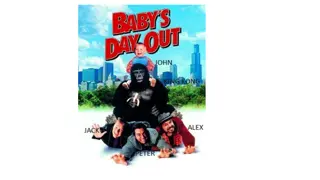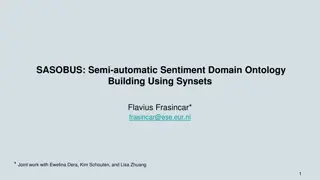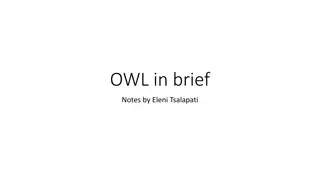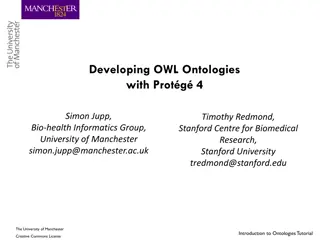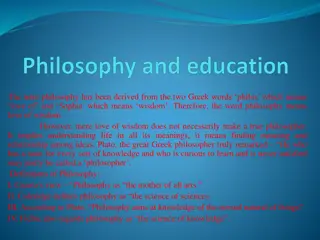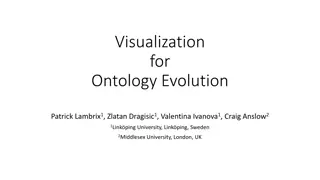Ontology Quiz: Test Your Knowledge on Computational Logic and Philosophy
Delve into the world of ontology with this quiz featuring questions on computational complexity, mereology, standardization of OWL, and foundational ontologies. Test your understanding on topics such as first-order predicate logic, parthood in mereology, and more. Challenge yourself and expand your knowledge on the fascinating field of ontology.
Download Presentation

Please find below an Image/Link to download the presentation.
The content on the website is provided AS IS for your information and personal use only. It may not be sold, licensed, or shared on other websites without obtaining consent from the author.If you encounter any issues during the download, it is possible that the publisher has removed the file from their server.
You are allowed to download the files provided on this website for personal or commercial use, subject to the condition that they are used lawfully. All files are the property of their respective owners.
The content on the website is provided AS IS for your information and personal use only. It may not be sold, licensed, or shared on other websites without obtaining consent from the author.
E N D
Presentation Transcript
Ontology Quiz ISAO 2016, 29 June 2016, Bolzano, Italy
Rules A team may choose the question number among the questions that have not passed the revue yet. A team has 1 minute to answer that question. If a team does not know the answer and did not try to answer the question, the question goes to another team immediately. Each team may search online for an answer for at most two questions. Note: The level of difficulty of the questions varies quite a lot.
Question 1 In terms of computational complexity, what is the principal difference between first order predicate logic and a description logic? Answer: DLs are decidable fragments of FOL
Question 2 Who proposed mereology about a century ago, and may be considered the father of mereology? Answer: Stanislaw Lesniewski
Question 3 Fill in the blank: Ollie s Macbook Air : Macbook Air, IAOA : ____? Answer: Organisation Basically: an instance stands to class/concept/universal
Question 4 What are in the corners of Ogden s semiotic triangle? Answer: sign/symbol, thought/reference/concept, and thing/referent
Question 5 In which year was OWL standardised? Answer: 2004
Question 6 Which foundational/top-level ontology is used most often for ontologies in biology? A. DOLCE B. BFO C. YAMATO D. GIST Answer: B
Question 7 Consider parthood in mereology. Which of the following is NOT a mereological parthood (be this part of or has part, for class or instance)? A. Katniss heart is part of Katniss body B. Swallowing is part of eating C. Clay is part of a vase D. South Tyrol is part of Italy Answer: C correct relation: constitution
Question 8 Which one is the odd one out, and why? A. Proton B. Neutron C. Electron D. Chronon Answer: D The other three are physical objects, whereas chronon is the smallest timeslice (used in several temporal logics)
Question 9 Which one is a foundational/top-level ontology? A. YATLO B. AWO C. OFU D. GFO Answer: D YATLO [yet another top level ontology] is made-up, AWO is a tutorial ontology, OFU has the letters in the wrong order (UFO is the name)
Question 10 What is the year of publication of Leonard and Goodman s Calculus of Individuals ? Answer: 1940
Question 11 If parthood is interpreted as set inclusion, what is the set-theoretic relation corresponding to overlap? Answer: Intersection
Question 12 Does the mereological principle of strong supplementation imply the extensionality of parthood? Answer: yes
Question 13 Who introduced the term gunk to refer to a domain in which everything can be divided for ever into smaller and smaller parts? Answer: David Lewis In: Parts of Classes (Oxford: Basil Blackwell, 1991)
Question 14 Given the principle of unique unrestricted composition (to the effect that every plurality of things has a unique fusion), which of the following additional principles will suffice to yield a complete axiomatization of classical mereology? A. antisymmetry of part B. transitivity of part C. weak supplementation Answer: C
Question 15 What is the definition of qua-object? Answer: in the character (or role) of. There are several more comprehensive descriptions, summarised neatly here: http://www.philosophie.ch/philipp/teaching/metaphy sics10/handout12.pdf
Question 16 Who s the author of Making the Social World: The Structure of Human Civilization ? A. Kevin Mulligan B. John Searle C. Barry Smith Answer: B
Question 17 When was the earliest published occurrence of the word ontology ? Answer: 1606, in Jacob Lorhard "Ogdoas Scholastica"
Question 18 In what sense, if any, could Paleontology be considered a branch of Ontology? Answer: It deals with, amongst other things, the classification and identification of extinct species. So one could argue yes because of the classification aspects and describing things. Or no, because they re extinct (realist, prescriptive etc.)
Question 19 Is a tornado an object, a process, or an event? Answer: It could be any of these depending on the point of view from which it is described - lots of scope for interesting discussion there!
Question 20 What does RCC stand for? Answer: Region Connection Calculus
Question 21 Sets have members as their most basic constituents. What is the counterpart to that in mereology? Answer: Atom
Question 22 What are the two core temporal constructs or operators from which others such as some time in the future , at all times , and the previous instant can be defined? Answer: The Since and Until operators
Question 23 Which of the following relation(s) really do require a temporal modality to represent its meaning fully? A. x precedes y B. x is derived from y C. x is an immutable part of y D. x participates in y Answer: A-C. Immutable part too: x is an essential part of y for as long as it is an instance of X. Participation not necessarily, though it could have some duration added to it.
Question 24 Which of the following one(s) is(are) OWL 2 profile(s)? A. OWL 2 Full B. OWL 2 EL C. OWL 2 TL D. OWL 2 DL Answer: B. OWL 2 DL is the most expressive DL-based OWL species, so not a profile. OWL 2 Full is even more expressive. TL is made-up (though that abbreviation is would be in line with QL and RL naming)
Question 25 Which DL reasoner revolutionised (substantially improved performance of) automated reasoning over DL knowledge bases in the 1990s? Answer: FaCT
Question 26 You want the automated reasoner to deduce that your mother s sister is your aunt. Which language feature do you need for that? Answer: OWL 2 s property chains, or, more generally: role composition
Question 27 You need to represent in an ontology the concept land-locked country (e.g., Switzerland, Lesotho). Which theory (logic and/or Ontology) will help you do that? Answer: (mereo)topology
Question 28 According to which foundational ontology is Death an achievement? Answer: DOLCE
Question 29 What is the difference between meronymy and mereology? Answer: meronymy refers to part in natural language phrases, mereology in Ontology meronymy, the part-of relation making up the hierarchies called meronomies or partonomies, bears on linguistic terms (hence the "nymy" suffix) denoting classes, as for hyperonymy in taxonomies, while in mereology the part-of relation bears on individuals
Question 30 Is the Ontology Quiz a continuant, an occurrent, both, or neither? Answer: depends The quiz qua collection of questions to be answered, which is a continuant; The actual event on Wednesday evening when the questions are posed and people attempt to answer them, which is an occurrent.
Question 31 What is DOL? Answer: The Distributed Ontology, Model and Specification Language
Question 32 Can an identity criterion be based on the identification of an essential part? Answer: no, unless the essential part comes with a clear identity criterion itself. Identity criteria are based on properties, not the on the identity of other entities on the pain of regression
Question 33 What is the proper term in ontology of those objects that in natural language are generally referred to with mass nouns? Answer: stuff, amount of matter That is, those uncountables, or only countable in quantities; e.g., gold, water, mayonnaise, beer
Question 34 What is the complexity of reasoning in ALC with respect to a TBox? A. ExpTime B. PSpace C. NP Answer: A. Reasoning w.r.t. TBox is ExpTime- complete. (It would be PSpace in case of an empty Tbox)
Question 35 What is the Description Logic reasoning service useful to generate a Taxonomy in an Ontology A. Query Answering B. Concept Subsumption C. Instance Checking Answer: B.
Question 36 DLs have sound and complete reasoning/inference algorithms. Why is this an important feature? A. No wrong inferences are drawn. B. All the correct inferences are drawn. C. Both A. and B. holds Answer: C., indeed A. Is true for a Sound algorithm, and B. Holds for complete algorithms.
Question 37 What is the main reason for the success of the DL-Lite fragments when using them to build Ontologies? A. Reasoning in DL-Lite is computationally tractable. B. Query answering is reducible to DBMS technology. C. They have a small number of constructors. Answer: B., indeed query answering over a DL-Lite ontology is FO-rewritable (i.e., it is AC0 in Data complexity as for DBMS queries).
Question 38 The notion of Certain Answer differs from that one of a query in a DBMS setting because: A. We need to deal with incomplete information. B. We need to deal with complete information. C. We need to make sure that the answer in certainly in the DBMS. Answer: A. Indeed, certain answer are those ones that hold in ALL possible models of the Knowledge Base (i.e., an incomplete DB + a set of constraints)
Question 39 Did the Deutsche Demokratische Republik (DDR East Germany) and the Bundesrepublik Deutschland (FDR - West Germany) share a border between 1949 and 1990? Answer: NO, because the Bundesrepublik Deutschland never officially recognized the DDR border. So, the border between the DDR and the FDR was established and declared unilaterally by the DDR.
Question 40 Since when does Germany exist? A. Since 18 January 1871 when, at the Versailles Palace, Princes of the German states gathered there to proclaim Wilhelm I of Prussia as German Emperor after the French capitulation in the Franco-Prussian War B. Since the Treaty of Verdun in 843, when the Carolingian Empire was divided into three parts, and the Eastern Part became known as the kingdom of Germany. C. Since the first Century CE, when Julius Ceasar used the term Germania to designate the tribes North of the Alps. Answer: Any of the above, depending on your criteria of what Germany is
Question 41 Which of the options below contains a list of UN member states, which are not recognized as sovereign states by at least one UN member? A. Republic of China, Armenia, Palestine B. South Korea, Armenia, Israel C. Israel, Kosovo, Palestine D. South Korea, Kosovo, South Ossetia Answer: South Korea is not recognized by North Korea, which is a UN member. Armenia is not recognized by Pakistan. Israeal is not recognized by 48 UN member states. Kosovo, Palestine and South Ossetia are not UN members.
Question 42 Do mountains exist? A. Yes, because humans refer to landforms such as Mont Blanc and Mont Everest in their discourse and everyday conversation. B. No, because all mathematical representations of terrain do not need the concept of a mountain . C. It depends on the definition of exist Answer: Mountains may be necessary concepts of a human description of landforms, but are not required in computer representations of terrain.
Acknowledgements The questions were set by: Maria Keet Achille Varzi Antony Galton Alessandro Artale Gilberto Camara Laure Vieu Roberta Ferrario
